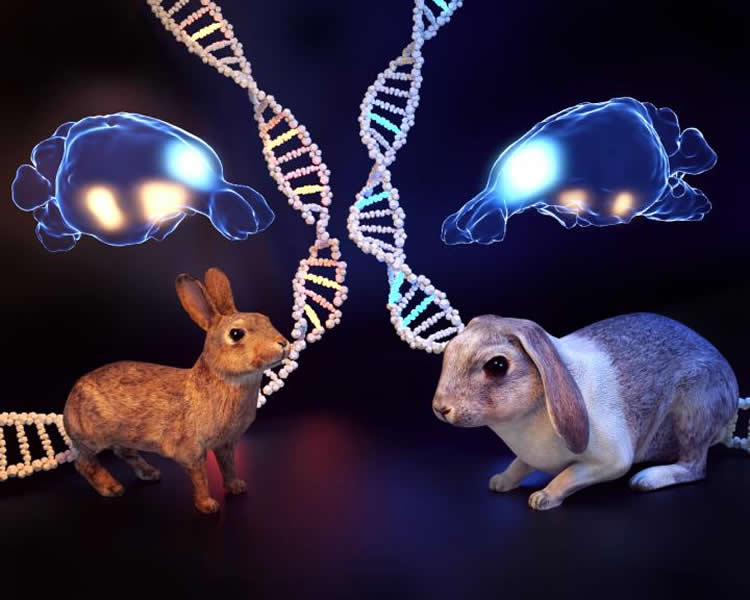Summary: A new MRI study reveals how domestication has affected the brain morphology in rabbits, specifically in the prefrontal cortex and amygdala.
Source: Uppsala University.
The most characteristic feature of domestic animals is their tame behaviour. An international team of scientists has now used high-resolution magnetic resonance imaging (MRI) to study how domestication has affected brain morphology in domestic rabbits. The results show that domestication has had a profound effect on brain morphology in particular regions of the brain involved in fear processing, the amygdala and medial prefrontal cortex. The study is published in PNAS.
In contrast to domestic rabbits, wild rabbits have a very strong flight response because they are hunted by eagles, hawks, foxes and humans, and therefore must be very alert and reactive to survive in the wild. In fact, Charles Darwin wrote in On the Origin of Species that “…no animal is more difficult to tame than the young of the wild rabbit; scarcely any animal is tamer than the young of the tame rabbit”. There is no doubt that this type of differences in behaviour between wild and domestic animals to a large extent are genetically determined.
‘In a previous study we reported that genetic differences between wild and domestic rabbits are particularly common in the vicinity of genes expressed during brain development,’ explains Miguel Carneiro, from CIBIO-InBIO, University of Porto, one of the leading authors on the paper. ‘In the present study we decided to use high-resolution MRI to explore if these genetic changes are associated with changes in brain morphology,’ says Miguel Carneiro.
The scientists raised eight domestic and eight wild rabbits under very similar conditions to minimize changes due to environmental effects. Furthermore, the brain MRI data were interpreted with sophisticated image analysis in which the scientist carrying out the analysis was unaware of the status animals (wild or domestic).
‘We observed three profound differences between the brains of wild and domestic rabbits,’ states Irene Brusini, first author and PhD student at KTH Royal Institute of Technology in Stockholm. ‘Firstly, wild rabbits have a larger brain-to-body size ratio than domestic rabbits. Secondly, domestic rabbits have a reduced amygdala and an enlarged medial prefrontal cortex. Thirdly, we noticed a generalized reduction in white matter structure in domestic rabbits.’

‘These differences in brain morphology make perfect sense in relation to the fact that domestic rabbits are less fearful and have an attenuated flight response compared with wild rabbits,’ explains Mats Fredrikson, Professor at Uppsala University and Karolinska Institutet, one of the senior authors on the paper. Our results show that an area involved in sensing fear (the amygdala) is smaller in size while an area controlling the response to fear (the medial prefrontal cortex) is larger in domestic rabbits. The reduced amount of white matter suggests that domestic rabbits have a compromised information processing possibly explaining why they are more slow reacting and phlegmatic than their wild counterparts.’
‘No previous study on animal domestication has explored changes in brain morphology between wild and domestic animals in such depth as we have done in this study,’ says Leif Andersson, Uppsala University, Swedish University of Agricultural Sciences and Texas A&M University. ‘When we initiated the study the concern was that any changes may be too subtle to be noticeable with MRI but that was clearly not the case as we noticed distinct changes. This study is not only important for our understanding of animal domestication but also for the basic understanding how variation in brain morphology can impact a complex behaviour like fear response,’ ends Leif Andersson.
Source: Leif Andersson – Uppsala University
Publisher: Organized by NeuroscienceNews.com.
Image Source: NeuroscienceNews.com image is credited to Fabian Sinzinger.
Original Research: Open access research for “Changes in brain architecture are consistent with altered fear processing in domestic rabbits” by Irene Brusini, Miguel Carneiro, Chunliang Wang, Carl-Johan Rubin, Henrik Ring, Sandra Afonso, José A. Blanco-Aguiar, Nuno Ferrand, Nima Rafati, Rafael Villafuerte, Örjan Smedby, Peter Damberg, Finn Hallböök, Mats Fredrikson, and Leif Andersson in PNAS. Published June 25 2018.
doi:10.1073/pnas.1801024115
[cbtabs][cbtab title=”MLA”]Uppsala University “Striking Differences in Brain Morphology Between Wild and Domestic Rabbits.” NeuroscienceNews. NeuroscienceNews, 25 June 2018.
<https://neurosciencenews.com/rabbit-brain-morphology-9445/>.[/cbtab][cbtab title=”APA”]Uppsala University (2018, June 25). Striking Differences in Brain Morphology Between Wild and Domestic Rabbits. NeuroscienceNews. Retrieved June 25, 2018 from https://neurosciencenews.com/rabbit-brain-morphology-9445/[/cbtab][cbtab title=”Chicago”]Uppsala University “Striking Differences in Brain Morphology Between Wild and Domestic Rabbits.” https://neurosciencenews.com/rabbit-brain-morphology-9445/ (accessed June 25, 2018).[/cbtab][/cbtabs]
Abstract
Changes in brain architecture are consistent with altered fear processing in domestic rabbits
The most characteristic feature of domestic animals is their change in behavior associated with selection for tameness. Here we show, using high-resolution brain magnetic resonance imaging in wild and domestic rabbits, that domestication reduced amygdala volume and enlarged medial prefrontal cortex volume, supporting that areas driving fear have lost volume while areas modulating negative affect have gained volume during domestication. In contrast to the localized gray matter alterations, white matter anisotropy was reduced in the corona radiata, corpus callosum, and the subcortical white matter. This suggests a compromised white matter structural integrity in projection and association fibers affecting both afferent and efferent neural flow, consistent with reduced neural processing. We propose that compared with their wild ancestors, domestic rabbits are less fearful and have an attenuated flight response because of these changes in brain architecture.






